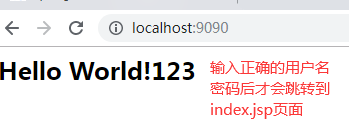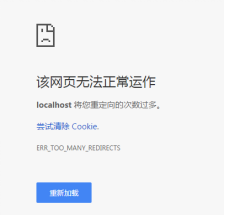前言:
我们之前在javaweb部分,以及ssm部分使用的是Filter或者拦截器,去做登陆控制,现在我们使用Spring Secutriy去做登陆控制
一、Spring Security的小demo
1、新建一个工程,导入maven依赖
<properties>
<spring.version>4.2.4.RELEASE</spring.version>
</properties>
<dependencies>
<dependency>
<groupId>org.springframework</groupId>
<artifactId>spring-core</artifactId>
<version>${spring.version}</version>
</dependency>
<dependency>
<groupId>org.springframework</groupId>
<artifactId>spring-web</artifactId>
<version>${spring.version}</version>
</dependency>
<dependency>
<groupId>org.springframework</groupId>
<artifactId>spring-webmvc</artifactId>
<version>${spring.version}</version>
</dependency>
<dependency>
<groupId>org.springframework</groupId>
<artifactId>spring-context-support</artifactId>
<version>${spring.version}</version>
</dependency>
<dependency>
<groupId>org.springframework</groupId>
<artifactId>spring-test</artifactId>
<version>${spring.version}</version>
</dependency>
<dependency>
<groupId>org.springframework</groupId>
<artifactId>spring-jdbc</artifactId>
<version>${spring.version}</version>
</dependency>
<dependency>
<groupId>org.springframework.security</groupId>
<artifactId>spring-security-web</artifactId>
<version>4.1.0.RELEASE</version>
</dependency>
<dependency>
<groupId>org.springframework.security</groupId>
<artifactId>spring-security-config</artifactId>
<version>4.1.0.RELEASE</version>
</dependency>
<dependency>
<groupId>javax.servlet</groupId>
<artifactId>servlet-api</artifactId>
<version>2.5</version>
<scope>provided</scope>
</dependency>
</dependencies>
<build>
<plugins>
<!-- java编译插件 -->
<plugin>
<groupId>org.apache.maven.plugins</groupId>
<artifactId>maven-compiler-plugin</artifactId>
<version>3.2</version>
<configuration>
<source>1.7</source>
<target>1.7</target>
<encoding>UTF-8</encoding>
</configuration>
</plugin>
<plugin>
<groupId>org.apache.tomcat.maven</groupId>
<artifactId>tomcat7-maven-plugin</artifactId>
<configuration>
<!-- 指定端口 -->
<port>9090</port>
<!-- 请求路径 -->
<path>/</path>
</configuration>
</plugin>
</plugins>
</build>
2、web.xml文件中的配置
<?xml version="1.0" encoding="UTF-8"?>
<web-app xmlns:xsi="http://www.w3.org/2001/XMLSchema-instance"
xmlns="http://java.sun.com/xml/ns/javaee"
xsi:schemaLocation="http://java.sun.com/xml/ns/javaee http://java.sun.com/xml/ns/javaee/web-app_2_5.xsd"
version="2.5">
<!--加载spring-security配置文件-->
<context-param>
<param-name>contextConfigLocation</param-name>
<param-value>classpath:spring-security.xml</param-value>
</context-param>
<listener>
<listener-class>
org.springframework.web.context.ContextLoaderListener
</listener-class>
</listener>
<filter>
<filter-name>springSecurityFilterChain</filter-name>
<filter-class>org.springframework.web.filter.DelegatingFilterProxy</filter-class>
</filter>
<filter-mapping>
<filter-name>springSecurityFilterChain</filter-name>
<url-pattern>/*</url-pattern>
</filter-mapping>
</web-app>
3、spring-security.xml配置文件
intercept-url 表示拦截页面
/* 表示的是该目录下的资源,只包括本级目录不包括下级目录
/** 表示的是该目录以及该目录下所有级别子目录的资源
form-login 为开启表单登陆
use-expressions 为是否使用使用 Spring 表达式语言( SpEL ),默认为true ,如果开启,则拦截的配置应该写成以下形式
login-processing-url=”/login2” 指定其他登录页
username-parameter="" password-parameter="" 来改写login的 用户名和属性名
<?xml version="1.0" encoding="UTF-8"?>
<beans:beans xmlns="http://www.springframework.org/schema/security"
xmlns:beans="http://www.springframework.org/schema/beans"
xmlns:xsi="http://www.w3.org/2001/XMLSchema-instance"
xsi:schemaLocation="http://www.springframework.org/schema/beans http://www.springframework.org/schema/beans/spring-beans.xsd
http://www.springframework.org/schema/security http://www.springframework.org/schema/security/spring-security.xsd">
<!-- 页面拦截规则 表示拦截的页面 use-expressions为是否适用SpEL,默认为true,-->
<http use-expressions="false">
<intercept-url pattern="/**" access="ROLE_USER" />
<!-- 开启表单登陆 ,若use-expressions设置为true,login-processing-url="/login2" 用于指定其他登录页-->
<form-login/>
</http>
<!-- 认证管理器 -->
<authentication-manager>
<authentication-provider>
<user-service>
<!--可以添加很多个 ROLE_USER角色,用户必须上面的角色-->
<user name="admin" password="123456" authorities="ROLE_USER"/>
</user-service>
</authentication-provider>
</authentication-manager>
</beans:beans>


二、创建我们自己的登陆界面
默认不登录,直接跳转到我们的登录界面,登陆失败,跳转到失败页面
1、创建login.html,login_error.html
<!DOCTYPE html>
<html>
<head>
<meta charset="UTF-8">
<title>登陆</title>
</head>
<body>
--欢迎的登陆我的系统--
<form action="/login" method="post">
用户名:<input name="username"><br>
密码:<input name="password"><br>
<button>登陆</button>
</form>
</body>
</html>
<!DOCTYPE html>
<html>
<head>
<meta charset="UTF-8">
<title>首页</title>
</head>
<body>
用户名或密码错误~~~
</body>
</html>
2、修改spring-security.xml配置文件
security="none" 设置此资源不被拦截.
login-page:指定登录页面。
authentication-failure-url:指定了身份验证失败时跳转到的页面。
default-target-url:指定了成功进行身份验证和授权后默认呈现给用户的页面。
csrf disabled="true"
<?xml version="1.0" encoding="UTF-8"?> <beans:beans xmlns="http://www.springframework.org/schema/security" xmlns:beans="http://www.springframework.org/schema/beans" xmlns:xsi="http://www.w3.org/2001/XMLSchema-instance" xsi:schemaLocation="http://www.springframework.org/schema/beans http://www.springframework.org/schema/beans/spring-beans.xsd http://www.springframework.org/schema/security http://www.springframework.org/schema/security/spring-security.xsd"> <!-- 以下界面不进行拦截 --> <http pattern="/login.html" security="none" ></http> <http pattern="/login_error.html" security="none" ></http> <!-- 配置拦截规则 --> <http use-expressions="false"> <!-- 拦截所有请求,跳转至登录页面。 配置角色 --> <intercept-url pattern="/*" access="ROLE_USER"/> <form-login login-page="/login.html" default-target-url="/index.html" authentication-failure-url="/login_error.html"/> <csrf disabled="true"/> </http> <!-- 认证管理器 --> <authentication-manager> <authentication-provider> <user-service> <!--可以添加很多个 ROLE_USER角色,用户必须上面的角色--> <user name="admin" password="123456" authorities="ROLE_USER"/> </user-service> </authentication-provider> </authentication-manager> </beans:beans>
如果你没有设置登录页security="none" ,将会出现以下错误

注意:
我在自己操作时下方的登陆页面写成了“login.html”忘记了“/”也会报上面的错误,希望大家注意
此时访问页面会跳转到我们自己创建的登陆界面,且只有输入正确的用户名和密码之后才会跳转到inex.html页面